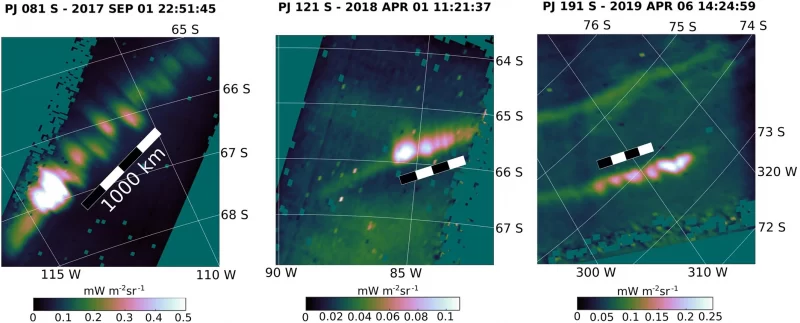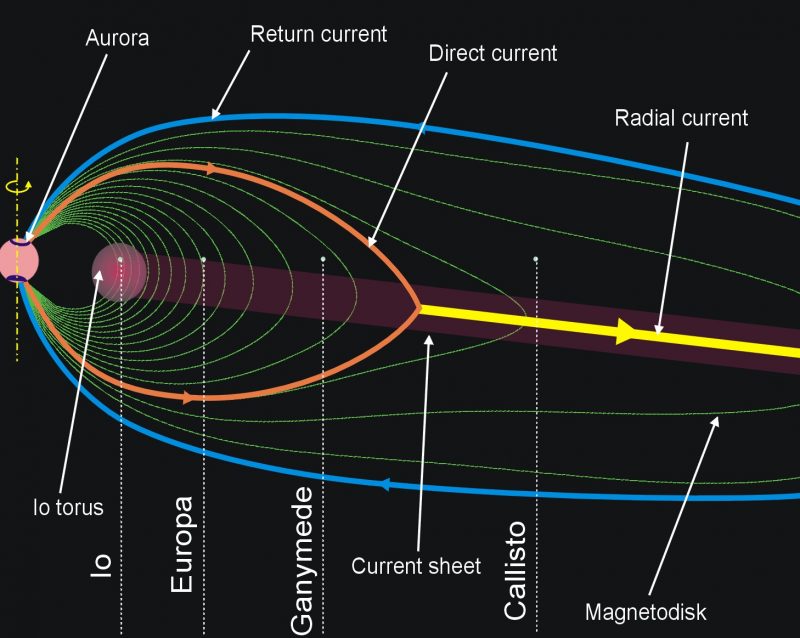Auroral tails for Io, Europa, Ganymede
Three of Jupiter’s large moons – Io, Europa and Ganymede – orbit the giant planet within its large and powerful magnetosphere. That is the sphere of Jupiter’s magnetic influence, carved out in the solar wind by Jupiter’s powerful magnetic field. Jupiter’s magnetosphere is immense, because its magnetic field is so intensely strong. It’s about 20,000 times stronger than Earth’s magnetic field. It’s the strongest magnetic field in our solar system (after the sun’s).
Among other things, Jupiter’s magnetic field drives the persistent auroras seen by multiple spacecraft at both Jovian poles. So it’s perhaps no surprise that the moons Io, Europa and Ganymede all have a connection to Jupiter’s auroras, too. These Jovian moons, the magnetosphere within which they orbit, Jupiter’s powerful magnetic field, and the giant auroras this magnetic field produces: all of these facets of nature contribute to an interconnected system. Scientists took another step toward understanding this grand system last month with a new paper published on what are called the auroral tails of Jupiter’s moons.
Because Jupiter and Earth orbit the sun more or less in the same plane, it hard for us on Earth to see Jupiter’s poles or its auroras very clearly. The Hubble Space Telescope has glimpsed them, but it’s not easy. But, in recent years, NASA’s Juno spacecraft has given researchers a ringside seat on the Jovian system. Juno arrived at Jupiter on July 4, 2016. The spacecraft now orbits the giant planet every 11 days in a highly elliptical orbit that carries it over the planet’s poles.
Auroral bright spots
Io, Europa and Ganymede produce bright spots in Jupiter’s auroras. The bright spots – called footprints by scientists – are well known and have been observed for decades. The spots correspond to magnetic field lines connecting Jupiter’s ionosphere with the moons. Scientists have used Juno’s Jovian Infrared Auroral Mapper (JIRAM) instrument to study not just the moon’s footprints within Jupiter’s auroras, but also their auroral tails on the gas giant’s atmosphere.
The new study, published August 11, 2021, reports that the unique pattern of the moons’ auroral tails is likely caused by interactions between the upper layer of Jupiter’s atmosphere (the ionosphere) and Jupiter’s strong magnetosphere, as the moons move through Jupiter’s sky.

What are auroral footprint tails?
The stronger the magnetic field of a planet, the larger its magnetosphere. A magnetosphere is the region around a planet where incoming charged particles from the sun, or in Jupiter’s case also from its moon Io, get trapped. This causes strong auroral activity, like the northern and southern lights (aurora borealis and aurora australis) here on Earth.
Scientists have known for some time that Jupiter’s moons contribute to its auroras. The Hubble Space Telescope glimpsed these auroral footprints within Jupiter’s auroras as early as 1998. Since then, researchers have been trying to figure out … how do they come to be?
Electrons captured in the planet’s magnetosphere travel along the magnetic field lines, in the same way that iron filings gather around a magnet. But when Jupiter’s moons are also traveling within the large magnetosphere of the planet, unusual things happen. The moons cause disturbances, perturbations, within the magnetosphere. This in its turn causes a process that accelerates the captured electrons toward the giant gas planet.
So, the perturbations steer electrons from the regions around the moons toward Jupiter’s upper atmosphere – the ionosphere – where they produce footprints of the moons on Jupiter’s atmosphere. The footprint itself is the main aurora emission, while the footprint tail is an extended series of fading dots trailing behind the footprint: auroral tails.
These emissions show up in ultraviolet, visible and infrared wavelengths of light. The emissions appear as a trail of bright spots with separations that vary at an average of around 185 miles (300 km). The tails can extend 1,250 miles (2,000 km) in length.
Juno spies the auroral tails
Juno’s JIRAM instrument revealed a rich, fine structure in the auroral footprint tails. These tails sport spaced-out bright sub-dots that become less intense the farther they get from their moons. A new paper, published August 11, 2021, in the American Geophysical Union’s peer-reviewed Journal of Geophysical Research: Space Physics, made the first examination of the intricate structure of Europa’s and Ganymede’s footprint tails.
The lead author, Alessandro Moirano of University of Rome La Sapienza, said in the paper:
As Jupiter’s magnetic field rotates faster than the orbit of the Galilean moons, the moons are continuously swept by the Jovian magnetic field and the co-rotating magnetospheric plasma. This interaction triggers an electromagnetic coupling of the plasma in the magnetosphere with the ionized portion of Jupiter’s atmosphere known as the ionosphere.
The coupling creates perturbations – waves – that interact with the ionosphere to create the footprint tails. The scientists hope to do more detailed studies on the feedback mechanism between the ionosphere and the magnetosphere in the future.

Bottom line: The Juno spacecraft observed footprint tails of auroras on Jupiter’s atmosphere. Three of Jupiter’s closest large moons create these auroral tails.
Source: Morphology of the Auroral Tail of Io, Europa, and Ganymede From JIRAM L-Band Imager
Read more about auroras on Jupiter
The post Auroral tails for Jupiter’s moons first appeared on EarthSky.
from EarthSky https://ift.tt/3o2bhm6
Auroral tails for Io, Europa, Ganymede
Three of Jupiter’s large moons – Io, Europa and Ganymede – orbit the giant planet within its large and powerful magnetosphere. That is the sphere of Jupiter’s magnetic influence, carved out in the solar wind by Jupiter’s powerful magnetic field. Jupiter’s magnetosphere is immense, because its magnetic field is so intensely strong. It’s about 20,000 times stronger than Earth’s magnetic field. It’s the strongest magnetic field in our solar system (after the sun’s).
Among other things, Jupiter’s magnetic field drives the persistent auroras seen by multiple spacecraft at both Jovian poles. So it’s perhaps no surprise that the moons Io, Europa and Ganymede all have a connection to Jupiter’s auroras, too. These Jovian moons, the magnetosphere within which they orbit, Jupiter’s powerful magnetic field, and the giant auroras this magnetic field produces: all of these facets of nature contribute to an interconnected system. Scientists took another step toward understanding this grand system last month with a new paper published on what are called the auroral tails of Jupiter’s moons.
Because Jupiter and Earth orbit the sun more or less in the same plane, it hard for us on Earth to see Jupiter’s poles or its auroras very clearly. The Hubble Space Telescope has glimpsed them, but it’s not easy. But, in recent years, NASA’s Juno spacecraft has given researchers a ringside seat on the Jovian system. Juno arrived at Jupiter on July 4, 2016. The spacecraft now orbits the giant planet every 11 days in a highly elliptical orbit that carries it over the planet’s poles.
Auroral bright spots
Io, Europa and Ganymede produce bright spots in Jupiter’s auroras. The bright spots – called footprints by scientists – are well known and have been observed for decades. The spots correspond to magnetic field lines connecting Jupiter’s ionosphere with the moons. Scientists have used Juno’s Jovian Infrared Auroral Mapper (JIRAM) instrument to study not just the moon’s footprints within Jupiter’s auroras, but also their auroral tails on the gas giant’s atmosphere.
The new study, published August 11, 2021, reports that the unique pattern of the moons’ auroral tails is likely caused by interactions between the upper layer of Jupiter’s atmosphere (the ionosphere) and Jupiter’s strong magnetosphere, as the moons move through Jupiter’s sky.

What are auroral footprint tails?
The stronger the magnetic field of a planet, the larger its magnetosphere. A magnetosphere is the region around a planet where incoming charged particles from the sun, or in Jupiter’s case also from its moon Io, get trapped. This causes strong auroral activity, like the northern and southern lights (aurora borealis and aurora australis) here on Earth.
Scientists have known for some time that Jupiter’s moons contribute to its auroras. The Hubble Space Telescope glimpsed these auroral footprints within Jupiter’s auroras as early as 1998. Since then, researchers have been trying to figure out … how do they come to be?
Electrons captured in the planet’s magnetosphere travel along the magnetic field lines, in the same way that iron filings gather around a magnet. But when Jupiter’s moons are also traveling within the large magnetosphere of the planet, unusual things happen. The moons cause disturbances, perturbations, within the magnetosphere. This in its turn causes a process that accelerates the captured electrons toward the giant gas planet.
So, the perturbations steer electrons from the regions around the moons toward Jupiter’s upper atmosphere – the ionosphere – where they produce footprints of the moons on Jupiter’s atmosphere. The footprint itself is the main aurora emission, while the footprint tail is an extended series of fading dots trailing behind the footprint: auroral tails.
These emissions show up in ultraviolet, visible and infrared wavelengths of light. The emissions appear as a trail of bright spots with separations that vary at an average of around 185 miles (300 km). The tails can extend 1,250 miles (2,000 km) in length.
Juno spies the auroral tails
Juno’s JIRAM instrument revealed a rich, fine structure in the auroral footprint tails. These tails sport spaced-out bright sub-dots that become less intense the farther they get from their moons. A new paper, published August 11, 2021, in the American Geophysical Union’s peer-reviewed Journal of Geophysical Research: Space Physics, made the first examination of the intricate structure of Europa’s and Ganymede’s footprint tails.
The lead author, Alessandro Moirano of University of Rome La Sapienza, said in the paper:
As Jupiter’s magnetic field rotates faster than the orbit of the Galilean moons, the moons are continuously swept by the Jovian magnetic field and the co-rotating magnetospheric plasma. This interaction triggers an electromagnetic coupling of the plasma in the magnetosphere with the ionized portion of Jupiter’s atmosphere known as the ionosphere.
The coupling creates perturbations – waves – that interact with the ionosphere to create the footprint tails. The scientists hope to do more detailed studies on the feedback mechanism between the ionosphere and the magnetosphere in the future.

Bottom line: The Juno spacecraft observed footprint tails of auroras on Jupiter’s atmosphere. Three of Jupiter’s closest large moons create these auroral tails.
Source: Morphology of the Auroral Tail of Io, Europa, and Ganymede From JIRAM L-Band Imager
Read more about auroras on Jupiter
The post Auroral tails for Jupiter’s moons first appeared on EarthSky.
from EarthSky https://ift.tt/3o2bhm6

Aucun commentaire:
Enregistrer un commentaire